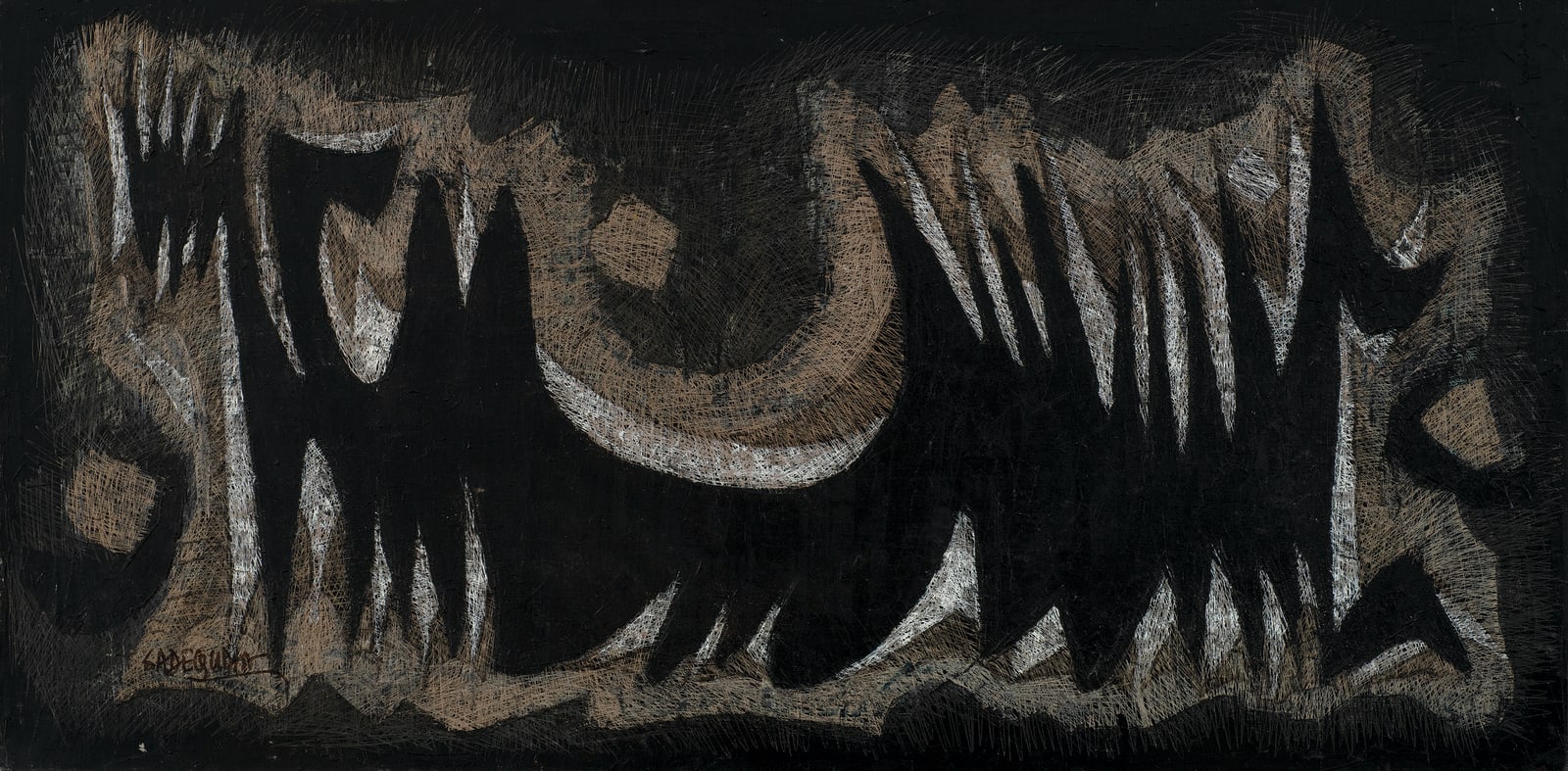Open a larger version of the following image in a popup:
 “With the commencement of his phantasmagorical exploration of form and substance, there emerges a series of abstract visual statements, strong and subtle, stripping, anatomising and recreating the skeletal forms beneath the visual flesh – skeletons of streets and cities, weeds and plants, men and women.”
“With the commencement of his phantasmagorical exploration of form and substance, there emerges a series of abstract visual statements, strong and subtle, stripping, anatomising and recreating the skeletal forms beneath the visual flesh – skeletons of streets and cities, weeds and plants, men and women.”
Faiz Ahmad Faiz, 1966
 “With the commencement of his phantasmagorical exploration of form and substance, there emerges a series of abstract visual statements, strong and subtle, stripping, anatomising and recreating the skeletal forms beneath the visual flesh – skeletons of streets and cities, weeds and plants, men and women.”
“With the commencement of his phantasmagorical exploration of form and substance, there emerges a series of abstract visual statements, strong and subtle, stripping, anatomising and recreating the skeletal forms beneath the visual flesh – skeletons of streets and cities, weeds and plants, men and women.”
Faiz Ahmad Faiz, 1966
Syed Sadequain
Untitled (Reclining Figure), circa 1962
Oil on canvas
60 x 120 cm
23 5/8 x 47 1/4 in
23 5/8 x 47 1/4 in
Signed 'Sadequain' lower left
Further images
This painting was acquired by a French Collector in the 1960s in Paris. He built a very large collection of artists working in Paris, including many of the leading artists...
This painting was acquired by a French Collector in the 1960s in Paris. He built a very large collection of artists working in Paris, including many of the leading artists of the day; Jean Degottex (1918 - 1988), Edgard Pillet (1912 - 1996) Anna-Eva Bergman (1909-1987) Bengt Lindstrom (1925 - 2008) Jean Messagier (1920 - 1999), Jean Degottex (1918 - 1988) Luis Tomasello (1915-2014), Robert Malaval (1937-1980) and many others.
Sadequain was announced a laureate of the 1961 Paris Biennale. An accolade that came with a grant to live in Paris for 5 months. In June and July 1962 Sadequain’s work, along with his fellow laureates; José Hernandez Delgadillo (Mexico), Piero Dorazio (Italy), Flavio Shiro (Brazil), Marko, Sustarsic (Yugoslavia) and Brett Whiteley (Australia), was exhibited at Musée Maison de la Culture in Le Havre as part of an exhibition celebrating those awarded. This was followed later that year with a solo exhibition in Paris at Galerie Lambert from the 3rd - 25th October 1962.
Painted in the first few years following his arrival in Paris, Reclining Figure (circa 1962) belongs to a suite of work starkly different from that produced in Pakistan at the end of the 1950s. Gone are the literal depictions of men and women and in come figures constructed of dark silhouettes and spikey, staccato calligraphic abstractions that were to define this period of his career. Sadequain worked and reworked the subject matter numerous times, usually placing himself as the protagonist, his long crooked fingers clearly visible.
Sadequain was announced a laureate of the 1961 Paris Biennale. An accolade that came with a grant to live in Paris for 5 months. In June and July 1962 Sadequain’s work, along with his fellow laureates; José Hernandez Delgadillo (Mexico), Piero Dorazio (Italy), Flavio Shiro (Brazil), Marko, Sustarsic (Yugoslavia) and Brett Whiteley (Australia), was exhibited at Musée Maison de la Culture in Le Havre as part of an exhibition celebrating those awarded. This was followed later that year with a solo exhibition in Paris at Galerie Lambert from the 3rd - 25th October 1962.
Painted in the first few years following his arrival in Paris, Reclining Figure (circa 1962) belongs to a suite of work starkly different from that produced in Pakistan at the end of the 1950s. Gone are the literal depictions of men and women and in come figures constructed of dark silhouettes and spikey, staccato calligraphic abstractions that were to define this period of his career. Sadequain worked and reworked the subject matter numerous times, usually placing himself as the protagonist, his long crooked fingers clearly visible.
Provenance
Private French collectionGrosvenor Gallery
Exhibitions
South Asian Modern Art 2022, Grosvenor Gallery, London, 10 June – 1 July 2022, No. 11, (illustrated in the exhibition catalogue)










